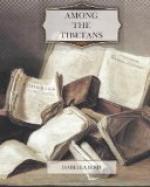We crossed the Baralacha Pass in wind and snow showers into a climate in which moisture began to be obvious. At short distances along the pass, which extends for many miles, there are rude semicircular walls, three feet high, all turned in one direction, in the shelter of which travellers crouch to escape from the strong cutting wind. My men suffered far more than on the two higher passes, and it was difficult to dislodge them from these shelters, where they lay groaning, gasping, and suffering from vertigo and nose-bleeding. The cold was so severe that I walked over the loftiest part of the pass, and for the first time felt slight effects of the ladug. At a height of 15,000 feet, in the midst of general desolation, grew, in the shelter of rocks, poppies (Mecanopsis aculeata), blue as the Tibetan skies, their centres filled with a cluster of golden-yellow stamens,- -a most charming sight. Ten or twelve of these exquisite blossoms grow on one stalk, and stalk, leaf, and seed-vessels are guarded by very stiff thorns. Lower down flowers abounded, and at the camping-ground of Patseo (12,000 feet), where the Tibetan sheep caravans exchange their wool, salt, and borax for grain, the ground was covered with soft greensward, and real rain fell. Seen from the Baralacha Pass are vast snowfields, glaciers, and avalanche slopes. This barrier, and the Rotang, farther south, close this trade route practically for seven months of the year, for they catch the monsoon rains, which at that altitude are snows from fifteen to thirty feet deep; while on the other side of the Baralacha and throughout Rupchu and Ladak the snowfall is insignificant. So late as August, when I crossed, there were four perfect snow bridges over the Bhaga, and snowfields thirty-six feet deep along its margin. At Patseo the tahsildar, with a retinue and animals laden with fodder, came to pay his respects to me, and invited me to his house, three days’ journey. These were the first human beings we had seen for three days.




